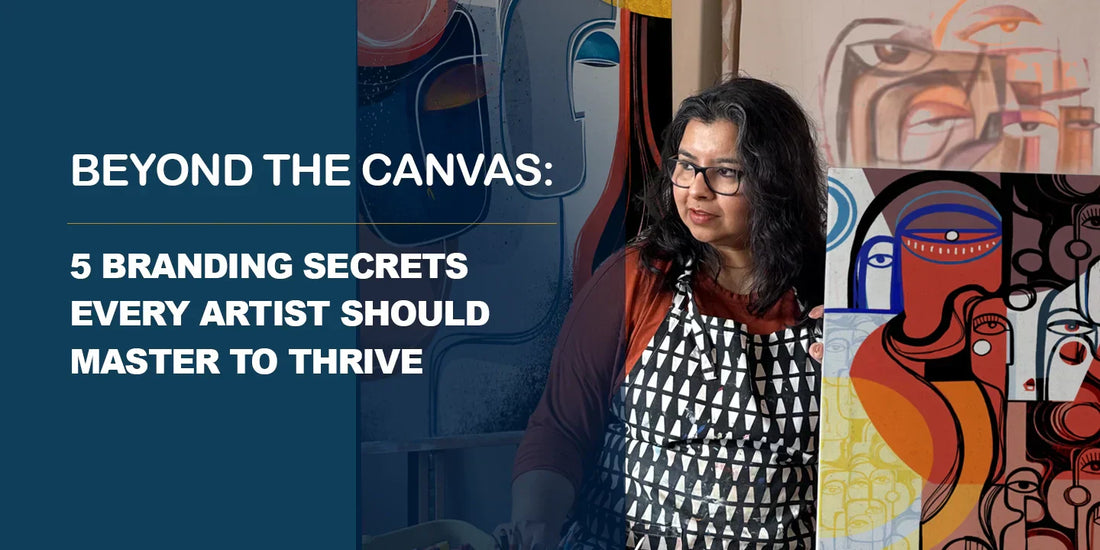
Beyond the Canvas: 5 Branding Secrets Every Artist Should Master to Thrive
Share
Introduction
In today’s saturated digital world, being a talented artist isn’t enough—you also need to be unmistakably you. Whether you're a painter, sculptor, illustrator, or mixed-media visionary, your art business hinges not only on your creative output but also on how your brand resonates with your audience. The truth? Buyers, collectors, and curators don’t just invest in art—they invest in stories and identities they connect with.
As we dive deeper into 2025, the most successful artists are those who’ve taken control of their narrative, built communities around their vision, and aligned their art with a distinct brand presence. And no—it doesn’t mean selling out. It means showing up authentically and strategically.
In this blog, I'll break down down five key branding strategies artists and creative entrepreneurs can use right now to elevate visibility, build loyal audiences, and grow a sustainable creative business. From clarifying your artistic voice to showing up with consistency on platforms like Instagram and LinkedIn, we’ll cover what’s working—and how to make it work for you.
1. Define Your Artistic Identity: More Than a Bio
Your brand starts with a clear understanding of who you are as an artist—what drives you, what stories you tell, and what impact you want to make.
Too many artists fall into the trap of generic bios like “I create abstract work inspired by emotions.” But what emotions? What makes your version of “abstract” uniquely yours?
Your artistic identity should include:
- Your visual language (colors, forms, materials).
- The recurring themes in your work.
- The values or philosophies that shape your process.
- Your personal story—what brought you to this moment?
Take artist Shantell Martin, for example. Her brand centers on a single, powerful question: “Who are you?”—a theme she explores visually through her black-and-white linework. That question becomes the anchor for her collaborations, talks, and exhibitions.
2. Craft a Cohesive Digital Presence (Without Losing the Magic)
Your online presence is your gallery, studio tour, and artist statement all rolled into one. It’s how most people will first experience your work—so make it cohesive and intentional. 
This doesn’t mean you need to be a graphic designer or influencer. It simply means that your platforms—your website, Instagram, LinkedIn, even your email footer—should reflect your voice and aesthetic.
Here’s how to keep it consistent:
- Use a unified color palette and font family (especially on your website and social graphics).
- Stick to a tone of voice in your captions and emails (e.g., poetic, playful, thoughtful).
- Use similar photography styles or filters across your feed.
Virginia Sin, a Brooklyn-based ceramicist, nails this. Her neutral, calming color scheme and minimalist photography echo the earthy textures of her clay work—creating a sense of serenity that mirrors her brand.
3. Use Storytelling to Connect and Sell (Not Just Showcase)
Your audience craves connection—not just content. Posting a finished painting is great. But telling the story behind it? That’s what builds a following. 
Share things like:
- The inspiration or emotion behind a piece.
- The creative or technical challenges you faced.
- The evolution of your style over time.
Artist and pop-culture provocateur Ashley Longshore is a prime example. Her bold, unapologetic voice shows up not just in her work but in her captions, interviews, and collector interactions. She uses humor, honesty, and cultural commentary to invite her audience into her world.
According to HubSpot (2024), storytelling-based posts receive 22x more engagement than promotional-only content.
4. Leverage LinkedIn and Instagram Like a Pro
Instagram might be your visual playground, but LinkedIn is your secret weapon for credibility and creative partnerships. 
On Instagram:
- Prioritize Reels and Stories—they get the most visibility.
- Use Highlights to archive key parts of your journey (studio, press, commissions).Keep captions meaningful—share thoughts, questions, or vulnerable moments.
On LinkedIn:
- Treat it like a digital journal and portfolio rolled into one.
- Share studio wins, behind-the-scenes looks at your business, and reflections on the creative process.
- Connect with curators, designers, brand reps, and gallery owners.
5. Collaborate and Network to Build Brand Equity
Smart collaborations amplify your brand, bring in new audiences, and add credibility to your practice. 
This could mean:
- Collaborating with brands (think: mural for a local coffee shop).
- Guest appearances on podcasts or panels.
- Joint exhibitions or social takeovers with other creatives.
Muralist Jen Stark did this brilliantly with her collaboration with Vans. Her trippy, vibrant visuals aligned perfectly with Vans’ skate-meets-art vibe, reinforcing her identity while exposing her to a global audience. 
Branding isn’t a corporate concept—it’s a creative one. And in 2025, it’s one of the most powerful tools an artist can use to carve out space in a noisy world. By defining your identity, showing up consistently online, telling real stories, and building smart collaborations, you’re not just promoting your art—you’re building a movement around your vision.
Because at the end of the day, people don’t just remember the art—they remember the artist.
So, the real question is: Who are you inviting them to remember?

